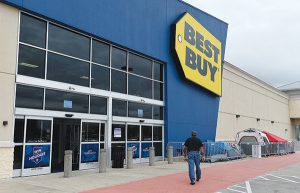There were no signs of a rebound in Best Buy Co’s latest financial results. While the company is painting a hopeful picture for the longer term, prospects for the core retail business and new at-home services remain lackluster. Investors could be forgiven for wondering whether some problems are too hard to fix.
The consumer-electronics retailer reported weaker-than-expected revenue for the three months ended in January. Comparable store sales fell by 2.3% from the same period last year and came in below analysts’ median estimate. Best Buy’s outlook for this year wasn’t any better, with the company predicting another drop in sales. Management vowed that the numbers will improve in a couple of years. After initially falling, the stock climbed 9%.
Don’t read too much into the early stock reaction. Best Buy’s shares have fallen 27% since the company’s last earnings report three months ago.
Like other brick-and-mortar retailers, the company has been trying to modernise its business by shifting toward e-commerce sales and rolling out a subscription-based customer support service. But Best Buy has unique challenges that are difficult to overcome.
Industry experts say the main differentiator for merchandising success is product curation. But unlike apparel or furniture, the consumer electronics category is fairly commoditised. According to Best Buy filings, about 60% of its revenue come from products made by just five companies — Apple, Samsung, HP, LG and Sony Group. Consumers can find the same lineup of major brands on sites like Amazon.com, so there is no compelling reason for them to shop at Best Buy.
Physical retail has other inherent disadvantages compared with online shopping, including smaller in-store inventory, less selection and high real estate costs. It’s no wonder Best Buy has been steadily shrinking its
store footprint from roughly 1,800 stores in 2014 to about 1,100 today.
—Bloomberg
 The Gulf Time Newspaper One of the finest business newspapers in the UAE brought to you by our professional writers and editors.
The Gulf Time Newspaper One of the finest business newspapers in the UAE brought to you by our professional writers and editors.
